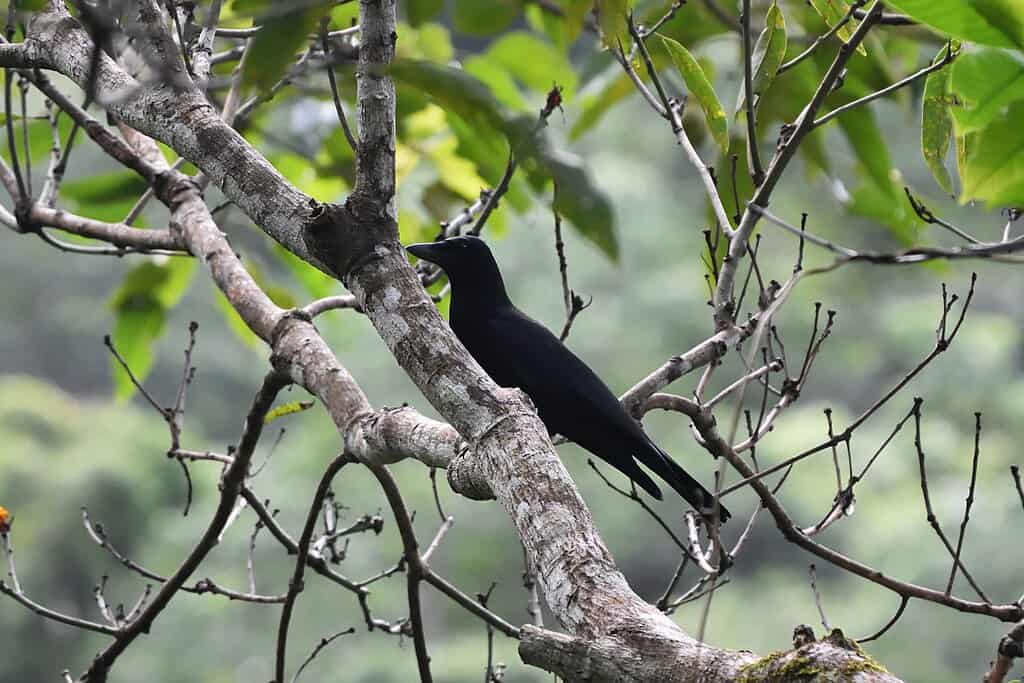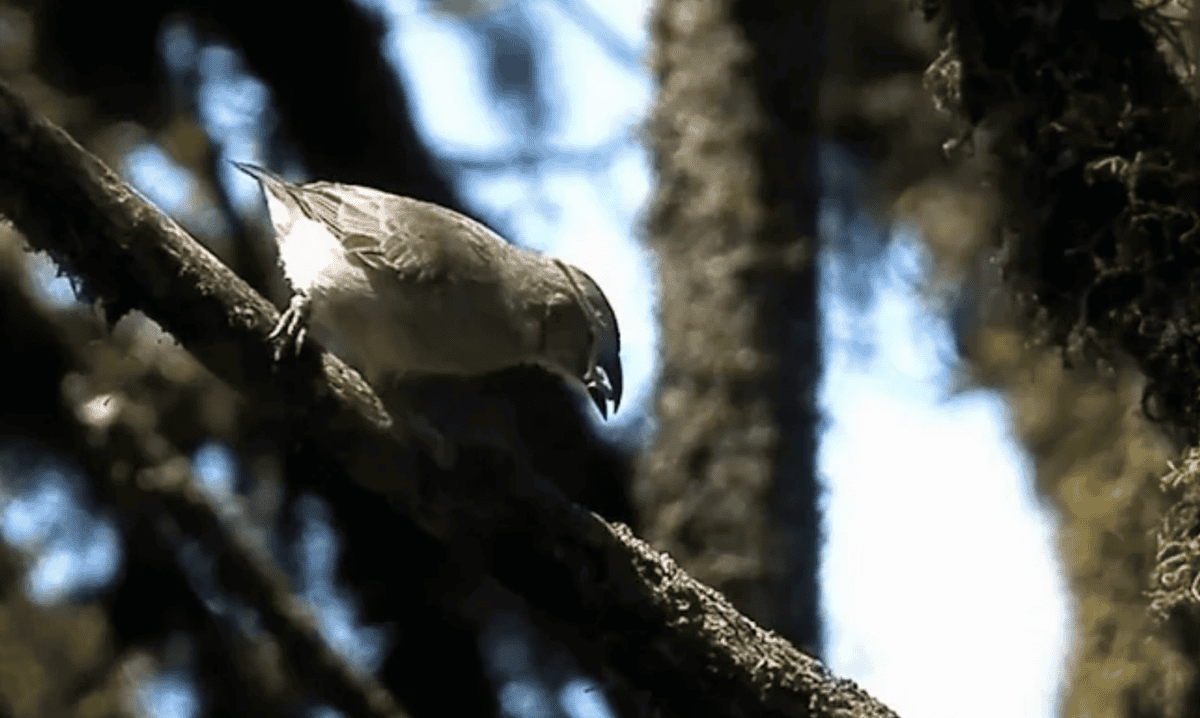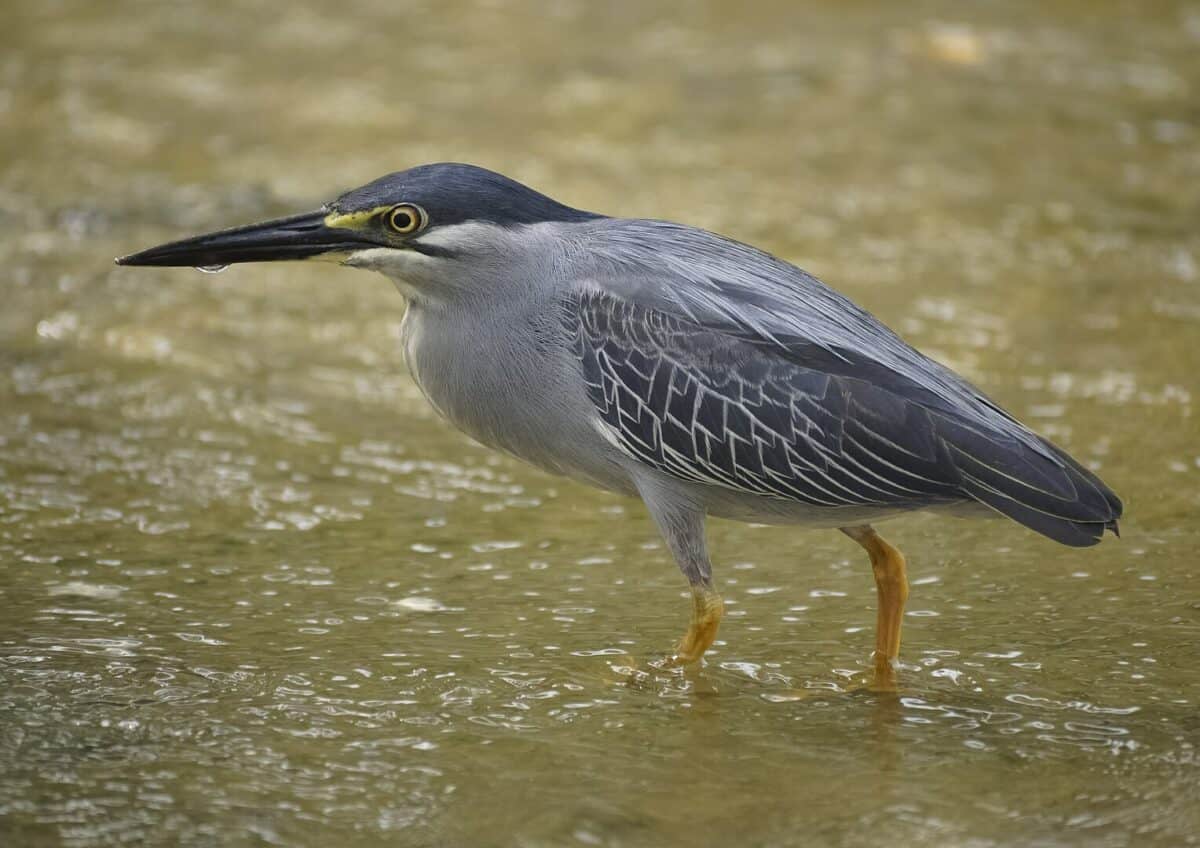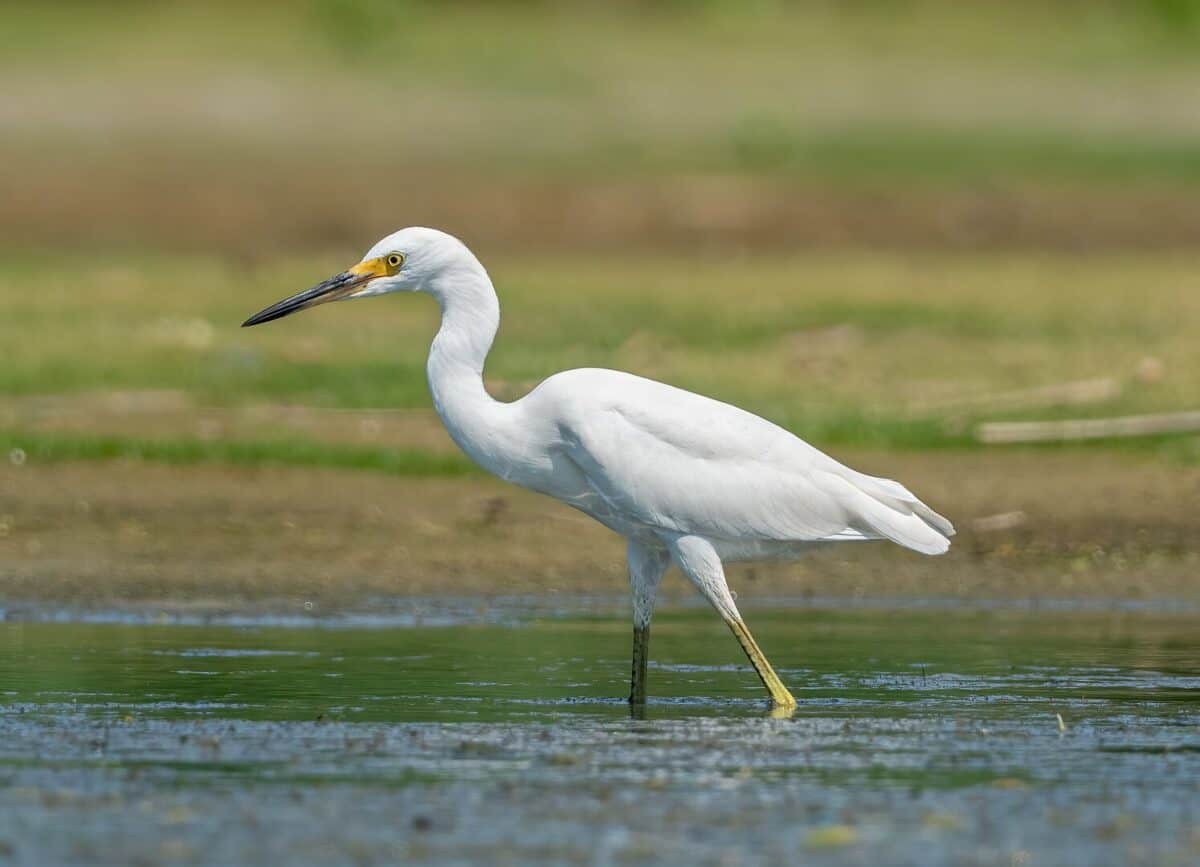The animal kingdom is full of surprising intelligence, but perhaps nothing demonstrates cognitive ability quite like tool use. While primates are famous for this behavior, birds have evolved remarkable tool-using capabilities, particularly for hunting and foraging. These avian innovators showcase problem-solving abilities previously thought beyond their reach. From crafting specialized implements to using found objects with precision, these feathered engineers challenge our understanding of bird intelligence. Their behaviors demonstrate not just instinctual patterns but learned skills passed through generations, suggesting cultural transmission similar to human knowledge sharing. Join us as we explore 13 wild birds that have mastered the art of tool use in their hunting strategies, revealing the extraordinary cognitive abilities hidden beneath their feathers.
New Caledonian Crows The Master Craftsmen

New Caledonian crows (Corvus moneduloides) stand as the undisputed champions of avian tool use. These remarkable birds, native to the South Pacific island of New Caledonia, craft specialized hooked tools from twigs and serrated tools from pandanus leaves with astonishing precision. Their hook-crafting process involves breaking a twig from a suitable tree, trimming the branches, and carefully crafting a hook at one end—a multi-step process demonstrating exceptional planning ability. The crows then use these tools to extract grubs and insects from tree crevices, with studies showing they can retrieve prey up to 10 times faster with tools than without them. Even more impressive, researchers have documented these birds modifying their tools when needed and selecting appropriate tools for specific tasks, suggesting a level of understanding about tool properties previously thought exclusive to primates. Perhaps most remarkably, young crows learn these techniques by observing adults, indicating a form of cultural transmission that reinforces their status as one of the most intelligent tool-using species on the planet.
Hawaiian Crows The Endangered Tool Users

The Hawaiian crow or ‘Alalā (Corvus hawaiiensis) represents one of the most tragic cases of a tool-using species. Currently extinct in the wild and surviving only in captivity, these birds demonstrate remarkable tool-using abilities that rival their New Caledonian cousins. Research has shown that Hawaiian crows instinctively use and modify sticks to extract food from hard-to-reach places, with captive birds showing this behavior without any prior training or observation. Their technique involves selecting straight sticks, sometimes stripping them of leaves, and using them with impressive dexterity to extract food from crevices. What makes this discovery particularly significant is that it suggests tool use evolved independently in these two crow species, as they are not closely related within the corvid family. Scientists consider this a rare case of convergent evolution of complex tool use, highlighting how similar ecological pressures can drive the development of sophisticated cognitive abilities. Conservation efforts are now underway to reintroduce these intelligent birds back into their native Hawaiian forests, where their tool-using abilities would once again serve them in the wild.
Egyptian Vultures Stone-Wielding Specialists

Egyptian vultures (Neophron percnopterus) employ one of the most straightforward yet effective tool-using techniques in the bird world. These striking white scavengers with yellow faces have developed a specialized method for cracking open ostrich eggs, whose shells are too thick for their beaks to penetrate directly. The vultures carefully select stones of appropriate size and weight, then use them as hammers to crack the eggs with repeated, precisely aimed throws. This behavior requires significant spatial coordination and an understanding of cause and effect. What’s particularly fascinating is that not all Egyptian vulture populations exhibit this behavior; it appears more common in regions where ostrich eggs form a significant part of their diet, suggesting the technique spreads culturally rather than being purely instinctual. Young vultures have been observed watching adults perform this stone-throwing technique multiple times before attempting it themselves, with their accuracy improving over time. With wild populations of Egyptian vultures declining dramatically across their range, conservation efforts are crucial to preserve not just the species but this unique example of avian cultural innovation.
Woodpecker Finches Nature’s Twig Manipulators

The woodpecker finch (Camarhynchus pallidus), one of Darwin’s famous Galápagos finches, represents one of the most well-documented cases of tool use in birds. Unlike true woodpeckers that use their specialized beaks and long tongues to extract insects, these small finches have evolved a different solution. They carefully select cactus spines or small twigs, sometimes trimming them to appropriate lengths, and use them as probes to extract insects from tree crevices and holes. During the dry season, when insects are harder to find, woodpecker finches can obtain up to 50% of their food using tools—making them among the most tool-dependent of all birds. Even more impressive, these finches display remarkable problem-solving flexibility, adjusting their tool selection based on the specific hunting challenge. They’ll choose longer implements for deeper holes and thinner tools for narrower crevices. This adaptive behavior occurs without formal teaching; young finches develop tool-using skills through observation and practice. The woodpecker finch provides a fascinating example of how environmental pressures can drive the evolution of complex behaviors, even in species without exceptionally large brains, demonstrating that necessity truly is the mother of invention in the animal kingdom.
Burrowing Owls Bait-Setting Hunters

Burrowing owls (Athene cunicularia) employ a fascinating form of tool use that demonstrates remarkable strategic thinking. These small, long-legged owls, native to the Americas, collect mammal dung and place it around the entrances of their underground burrows. This behavior initially puzzled scientists until they discovered its ingenious purpose—the dung acts as bait to attract dung beetles and other insects, which the owls then capture and eat. This represents a sophisticated form of tool use where the owls manipulate their environment to lure prey directly to them, essentially creating a food trap. Research has shown that burrows with dung attract significantly more beetles than those without, with some studies suggesting up to a 10-fold increase in insect availability. What’s particularly interesting is how this behavior varies across different populations depending on local insect availability and seasonal conditions. In some regions, burrowing owls will also collect other materials like shiny objects, cloth pieces, or paper, possibly serving similar bait functions or as nest insulation. This adaptable tool-using strategy helps these small predators conserve energy while maximizing hunting success, showing how cognitive flexibility can evolve as a response to ecological challenges.
Green Herons The Clever Fishers

Green herons (Butorides virescens) demonstrate one of the most impressive examples of bait fishing in the bird world. These medium-sized wading birds have been observed collecting and dropping small objects—such as twigs, feathers, insects, berries, or even bread crusts provided by humans—onto the water’s surface to attract fish. When fish approach to investigate the potential food item, the heron strikes with lightning speed, catching the curious fish with its sharp beak. This sophisticated hunting technique requires several complex cognitive abilities: recognizing that fish are attracted to floating objects, understanding the concept of bait, and exercising the patience to wait for the perfect moment to strike. Studies have documented green herons selecting specific bait types based on local fish preferences and adjusting their technique according to water conditions, demonstrating remarkable adaptability. While not all green herons exhibit this behavior, it appears to spread through populations via social learning, with juveniles observing and emulating successful adults. What makes this even more impressive is that green herons have relatively small brains compared to known intelligent birds like corvids, suggesting that complex tool use may be more widespread among birds than previously thought. This bait-fishing behavior represents an excellent example of how ecological pressures can drive the evolution of sophisticated problem-solving abilities across diverse bird families.
Rooks The Adaptable Problem Solvers

Rooks (Corvus frugilegus), members of the highly intelligent corvid family, display impressive tool-using abilities despite rarely using tools in the wild. In laboratory settings, rooks have demonstrated remarkable problem-solving capabilities that suggest a deep understanding of physical principles. When presented with food floating in a tube of water beyond their reach, rooks quickly learn to drop stones into the tube to raise the water level—understanding the displacement principle without prior training. Even more impressively, they select larger stones over smaller ones, recognizing that bigger objects raise the water level more efficiently. Rooks have also been observed bending wire into hooks to retrieve food and using sticks as probes to access hard-to-reach items. What makes these abilities particularly fascinating is that, unlike New Caledonian crows, rooks are not habitual tool users in their natural environment. This suggests they possess the cognitive capacity for complex tool use as a latent ability, which they can implement when circumstances require it. Their performance in experimental settings indicates that tool use may be more about general problem-solving intelligence rather than specialized adaptations. As highly social birds that form large colonies, rooks likely benefit from observational learning that helps spread innovative behaviors through their communities. Their flexibility in approaching novel challenges reveals how intelligence can evolve in species that face varied ecological pressures requiring adaptable solutions.
Great Grey Shrikes Living Larders

Great grey shrikes (Lanius excubitor) employ a macabre but effective form of tool use that has earned them the nickname “butcher birds.” These predatory songbirds have developed the remarkable habit of impaling their prey—including large insects, small mammals, and even other birds—on thorns, barbed wire, or sharp twigs. This behavior serves multiple sophisticated purposes. Primarily, it functions as a food storage system, creating natural “larders” that allow the shrikes to preserve surplus food for later consumption, particularly valuable during breeding season or harsh weather when prey is scarce. Studies have found individual shrikes maintaining dozens of cached prey items across their territories. Additionally, this impaling technique helps these relatively small birds manage prey that would otherwise be too large to handle, effectively using thorns as nature’s carving forks to tear apart their catch into manageable pieces. The sharp objects act as surrogate talons, compensating for the shrikes’ lack of the powerful feet possessed by true raptors. Perhaps most fascinating is how this behavior may serve a communication function—male shrikes sometimes create elaborate displays of impaled prey, potentially to advertise their hunting prowess to potential mates. Researchers have documented that females indeed pay attention to these macabre displays when selecting partners. This multi-purpose tool use demonstrates how behavioral adaptations can solve various ecological challenges simultaneously, showcasing the shrikes’ remarkable cognitive flexibility.
Hermit Thrushes Leaf-Lifting Foragers

Hermit thrushes (Catharus guttatus) demonstrate a subtler but nonetheless effective form of tool use in their foraging behavior. These melodious songbirds of North American forests have been observed using leaves as tools to assist in their search for food. When foraging on the forest floor, hermit thrushes will carefully select fallen leaves and use them to sweep aside forest litter, exposing the insects, spiders, and other invertebrates hiding beneath. This leaf-lifting technique requires precise manipulation, as the birds must grip the leaf in their beak at just the right angle to effectively move other debris without damaging or losing the tool. Research has shown that thrushes using this technique can increase their foraging efficiency by up to 30% compared to simple ground pecking. What makes this behavior particularly interesting is its seasonal variation—thrushes employ leaf-lifting most frequently during autumn and early winter when the forest floor is covered with freshly fallen leaves, and insects are beginning to seek shelter in the leaf litter. The behavior appears to be socially transmitted, with younger birds learning the technique by observing successful adults. This example of tool use is less elaborate than that seen in crows or finches but represents an important case of how even relatively simple tool use can significantly enhance foraging success. It also suggests that similar low-complexity tool behaviors might be widespread among birds but have gone largely unnoticed by researchers focused on more obvious examples.
Black Palm Cockatoos Percussive Tool Users

Black palm cockatoos (Probosciger aterrimus) of northern Australia and New Guinea display one of the most remarkable and unique forms of tool use in the avian world. Male cockatoos fashion drumsticks from broken branches, carefully selecting sticks of appropriate length and thickness, sometimes even trimming them to improve their function. They then use these tools as percussion instruments, rhythmically striking hollow tree trunks or branches to create loud, resonating sounds that can travel over a kilometer through dense forest. This sophisticated behavior serves as a territorial advertisement and courtship display, with males performing these drumming rituals while vocalizing and displaying their dramatic red cheek patches. Research has documented individual males maintaining personal “drumming posts” that they return to repeatedly, with some posts showing evidence of generations of use through distinct wear patterns. What makes this behavior particularly fascinating is that it represents a rare example of tool use for communication rather than feeding, demonstrating how cognitive abilities can evolve to serve social functions. Each male appears to develop a signature rhythm, allowing females to potentially identify individual drummers by their unique patterns. With their exceptional cognitive abilities, large brains, and complex social structures, these endangered cockatoos represent an important example of how tool use can evolve along different pathways to serve diverse biological functions, expanding our understanding of avian intelligence and cultural transmission.
American Crows Versatile Tool Innovators

American crows (Corvus brachyrhynchos) demonstrate remarkable adaptability in their approach to tool use. Although less specialized than their New Caledonian cousins, these highly intelligent corvids show impressive innovation in urban and rural environments alike. Researchers have documented American crows fashioning tools from various materials, including twigs, wire, and even human artifacts like paper clips or plastic utensils. They use these tools to probe for insects in tree bark, extract food from narrow containers, and even to place on ant nests, allowing the ants to swarm the tool before the crow uses it for “anting”—a behavior where birds use formic acid from ants for feather maintenance. What makes American crows particularly fascinating is their ability to solve novel problems through tool use. In experimental settings, they quickly learn to drop stones into water-filled tubes to raise water levels and access floating food, showing an intuitive understanding of water displacement. They’ve also been observed crafting tools sequentially, using one tool to obtain another that’s better suited for a specific task—demonstrating remarkable planning abilities. Their tool use appears highly context-dependent, with urban crows often showing more innovative approaches than their rural counterparts, suggesting environmental challenges drive creative problem-solving. As highly social birds with extended family groups, young crows have ample opportunity to learn these skills from experienced adults, creating a system of cultural transmission that allows successful innovations to spread through populations. This behavioral flexibility likely contributes to their remarkable success across diverse North American habitats, from wilderness to urban centers.
Snowy Egrets Foot-Stirring Specialists

Snowy egrets (Egretta thula) employ a sophisticated form of tool use that involves using their own body parts as implements to enhance hunting success. These elegant white wading birds have developed a technique known as “foot-stirring,” where they extend one bright yellow foot forward and rapidly vibrate it on the water’s surface or substrate. This calculated action stirs up the muddy bottom, flushing out small fish, crustaceans, and aquatic insects that might otherwise remain hidden. The egrets then quickly strike with their sharp beaks to capture the disturbed prey. Research has documented that snowy egrets using this technique can increase their feeding success rate by up to 3.6 times compared to passive waiting or simple walking while hunting. What makes this behavior particularly interesting is its variation—some egrets use a shuffle technique in deeper water, while others employ a more vigorous paddling motion in shallow areas. They adjust these movements based on water clarity, depth, and substrate type, showing remarkable behavioral flexibility. While using body parts as tools (sometimes called somatic tool use) might seem less impressive than manipulating external objects, it requires sophisticated neural control, spatial awareness, and learning. Young egrets develop this technique through observation and practice, gradually refining their movements to maximize efficiency. This form of tool use represents an important evolutionary innovation that allows these birds to exploit food resources inaccessible to non-tool-using competitors, demonstrating how cognitive abilities can evolve to fill specific ecological niches even without the manipulation of external objects.
Striated Herons Bait Fishing Innovators

Striated herons (Butorides striata), close relatives of green herons, have independently evolved sophisticated bait fishing techniques that showcase remarkable problem-solving abilities. These small wading birds, found across tropical and subtropical regions worldwide, use a variety of objects as fishing lures—including feathers,
Conclusion

The birds featured in this list offer compelling evidence that tool use is not confined to primates or mammals with large brains. From crows crafting intricate hooks to herons baiting fish with remarkable foresight, these avian species reveal a spectrum of intelligence rooted in adaptability, learning, and innovation. Their diverse tool-using behaviors highlight how environmental pressures and social learning can drive the evolution of complex cognitive strategies across bird families. These feathered tool users challenge long-held assumptions about what it means to be intelligent and suggest that the capacity for innovation may be more widespread—and more nuanced—than we ever imagined. As we continue to study these remarkable birds, they not only expand our understanding of animal cognition but also deepen our appreciation for the ingenuity thriving in the natural world.
- 10 Common Chicken Behaviors and What They Mean - August 9, 2025
- 14 Creatures That Can Freeze and Thaw Back to Life - August 9, 2025
- 10 Animals That Risked Their Lives to Save Humans - August 9, 2025

